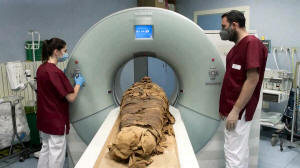|
The
mummy of Ankhekhonsu, an ancient Egyptian priest, was
transferred from Bergamo's Civic Archaeological Museum to
Milan's Policlinico hospital, where experts will shed light on
his life and the burial customs of almost 3,000 years ago.
"The mummies are practically a biological museum, they are like
a time capsule," said Sabina Malgora, the director of the Mummy
Project Research.
Malgora said information on the mummy's name comes from the
sarcophagus dated between 900 and 800 BC, where Ankhekhonsu -
which means 'the god Khonsu is alive' - is written five times.
Researchers believe they can reconstruct the life and death of
the Egyptian priest and understand which kinds of products were
used to mummify the body.
"Studying ancient diseases and wounds is important for modern
medical research ... we can study the cancer or the
arteriosclerosis of the past and this can be useful for modern
research," she said.
(Reporting by Alex Fraser; writing by Angelo Amante, editing by
Gavin Jones and Janet Lawrence)
[© 2021 Thomson Reuters. All rights
reserved.] Copyright 2021 Reuters. All rights reserved. This material may not be published,
broadcast, rewritten or redistributed.
Thompson Reuters is solely responsible for this content.

|
|




